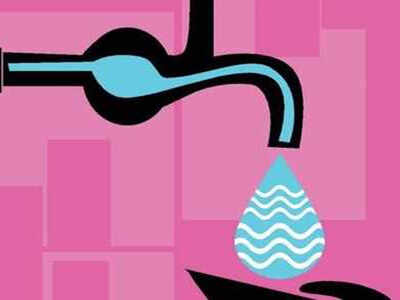
PATNA: The growing scarcity of groundwater with the advent of summer in different parts of the state has made the fight against Covid-19 more challenging. Washing hands every now and then and maintaining cleanliness require lots of water. It is really a herculean task for a vast majority of the people who do not have access to safe drinking water.
If the health department advisory is to be followed, washing hands with water and soap for 20 seconds repeatedly after visiting a public place or touching a surface outside home, after coughing, sneezing or blowing nose and, of course, after using toilet or taking out garbage and before and after eating, would easily amount to 10 times a day. A single 20-second wash consumes at least two litres of water. And, for a family of four washing 10 times a day each means 80 litres just for handwash — an unimaginable luxury in most cities and villages of the state, say experts.
In most slums of the city, there is one shared tap for every four or five households. “In these circumstances, people face a disconcerting choice of washing hands or maintaining social distance. It is difficult to practise both simultaneously for warding off the disease,” said environmentalist Mehta Nagendra Singh.
“In most villages and mufassil areas, water is scarce and people depend on wells, tube wells or small ponds for meeting their drinking and domestic requirements. Ponds and wells imply stagnant water. Thus, the situation is likely to worsen further if contaminated water is consumed without adequate purification,” Singh said.
According to a study carried out by the Central Ground Water Board (CGWB), groundwater reservoirs in as many as 11 blocks of the state are in semi-critical condition. These blocks are Gaya Sadar, Rajgir, Nagar Nausa in Nalanda, Meskaur in Nawada, Kurtha in Arwal, Birpur and Naokothi in Begusarai, Masaurhi and Sampatchak in Patna, Mushhari in Muzaffarpur and Tajpur in Samastipur district. These blocks would be in critical condition as soon as the development stage exceeds 90%, the study suggests.
The study further suggests that at least eight cities, including the state capital, are likely to face severe water crisis soon. Gaya and Bhagalpur are already experiencing declining groundwater levels and consequent scarcity. And, the cities of Muzaffarpur, Darbhanga, Ara, Munger and Biharsharif are likely to face the crisis in near future, it adds. People of Gaya and Munger are facing acute shortage of groundwater due to over-exploitation of this resource over the years. “With the drying of aquifers and lowering down of the water level, harmful chemical elements are leaching into the groundwater system and contaminating it. How can people fight against deadly coronavirus with the contaminated water,” asks Munger University vice-chancellor Ranjit Kumar Verma.
State PHED minister Vinod Narayan Jha, however, claims there is no such groundwater scarcity in the state and people would not face any problem in taking the precautionary measures related to handwashing or maintaining cleanliness. “The state had faced acute water scarcity last year, but there has been considerable improvement in the situation following the implementation of ‘Jal-Jivan-Hariyali’ scheme. In fact, the groundwater level has gone up by seven to 12 feet in different districts and, hence, there is hardly any problem of water for the time being. And, if any such problem arises in future, necessary steps would be taken through tankers in scarce regions,” Jha adds.
If the health department advisory is to be followed, washing hands with water and soap for 20 seconds repeatedly after visiting a public place or touching a surface outside home, after coughing, sneezing or blowing nose and, of course, after using toilet or taking out garbage and before and after eating, would easily amount to 10 times a day. A single 20-second wash consumes at least two litres of water. And, for a family of four washing 10 times a day each means 80 litres just for handwash — an unimaginable luxury in most cities and villages of the state, say experts.
In most slums of the city, there is one shared tap for every four or five households. “In these circumstances, people face a disconcerting choice of washing hands or maintaining social distance. It is difficult to practise both simultaneously for warding off the disease,” said environmentalist Mehta Nagendra Singh.
“In most villages and mufassil areas, water is scarce and people depend on wells, tube wells or small ponds for meeting their drinking and domestic requirements. Ponds and wells imply stagnant water. Thus, the situation is likely to worsen further if contaminated water is consumed without adequate purification,” Singh said.
According to a study carried out by the Central Ground Water Board (CGWB), groundwater reservoirs in as many as 11 blocks of the state are in semi-critical condition. These blocks are Gaya Sadar, Rajgir, Nagar Nausa in Nalanda, Meskaur in Nawada, Kurtha in Arwal, Birpur and Naokothi in Begusarai, Masaurhi and Sampatchak in Patna, Mushhari in Muzaffarpur and Tajpur in Samastipur district. These blocks would be in critical condition as soon as the development stage exceeds 90%, the study suggests.
The study further suggests that at least eight cities, including the state capital, are likely to face severe water crisis soon. Gaya and Bhagalpur are already experiencing declining groundwater levels and consequent scarcity. And, the cities of Muzaffarpur, Darbhanga, Ara, Munger and Biharsharif are likely to face the crisis in near future, it adds. People of Gaya and Munger are facing acute shortage of groundwater due to over-exploitation of this resource over the years. “With the drying of aquifers and lowering down of the water level, harmful chemical elements are leaching into the groundwater system and contaminating it. How can people fight against deadly coronavirus with the contaminated water,” asks Munger University vice-chancellor Ranjit Kumar Verma.
State PHED minister Vinod Narayan Jha, however, claims there is no such groundwater scarcity in the state and people would not face any problem in taking the precautionary measures related to handwashing or maintaining cleanliness. “The state had faced acute water scarcity last year, but there has been considerable improvement in the situation following the implementation of ‘Jal-Jivan-Hariyali’ scheme. In fact, the groundwater level has gone up by seven to 12 feet in different districts and, hence, there is hardly any problem of water for the time being. And, if any such problem arises in future, necessary steps would be taken through tankers in scarce regions,” Jha adds.

Coronavirus outbreak
Trending Topics
LATEST VIDEOS
More from TOI
Navbharat Times
Featured Today in Travel
Quick Links
Kerala Coronavirus Helpline NumberHaryana Coronavirus Helpline NumberUP Coronavirus Helpline NumberBareilly NewsBhopal NewsCoronavirus in DelhiCoronavirus in HyderabadCoronavirus in IndiaCoronavirus symptomsCoronavirusRajasthan Coronavirus Helpline NumberAditya ThackerayShiv SenaFire in MumbaiAP Coronavirus Helpline NumberArvind KejriwalJammu Kashmir Coronavirus Helpline NumberSrinagar encounter
Get the app








